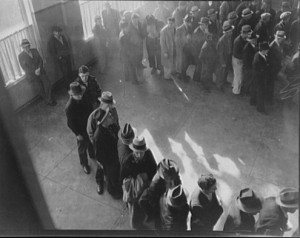- Home
- News
- Features
- Topics
- Labor
- Management
- Opinions/Blogs
- Tools & Resources
Employment Report: Unemployment Unchanged, Workers Still Discouraged, No New Jobs
Employment in America is still stagnate.
New employment data from Bureau of Labor Statistics show the job market remains sluggish and is smaller than five years ago.
Total nonfarm payroll employment increased by 157,000 in January. The unemployment rate was unchanged at 7.9%, and has been at or near that level since September 2012, the U.S. Bureau of Labor Statistics reported Feb. 1, 2013. The number of unemployed, 12.3 million, was also unchanged in January.
Retail, construction, health care, and wholesale trade added jobs during the month.
From the BLS employment report–
Employment Survey Data
Among the major worker groups, the unemployment rates for adult men (7.3%), adult women (7.3%), teenagers (23.4%), whites (7.0%), blacks (13.8%), and Hispanics (9.7%) showed little or no change in January.
The jobless rate for Asians was 6.5% (not seasonally adjusted), little changed from a year earlier.
In January, the number of long-term unemployed (those jobless for 27 weeks or more) was about unchanged at 4.7 million and accounted for 38.1% of the unemployed.
Both the employment-population ratio (58.6%) and the civilian labor force participation rate (63.6%) were unchanged in January.
The number of persons employed part time for economic reasons, at 8 million, changed little in January. These individuals were working part time because their hours had been cut back or because they were unable to find a full-time job.
In January, 366,000 marginally attached 2.4 million people to the labor force, down from a year earlier. (The data are not seasonally adjusted.)
These individuals were not in the labor force, wanted and were available for work, and had looked for a job sometime in the prior 12 months. They were not counted as unemployed because they had not searched for work in the four weeks preceding the survey.
Among the marginally attached, there were 804,000 discouraged workers in January, a decline of 255,000 from a year earlier. (The data are not seasonally adjusted.)
Discouraged workers are persons not currently looking for work because they believe no jobs are available for them.
The remaining 1.6 million persons marginally attached to the labor force in January had not searched for work in the four weeks preceding the survey for reasons such as school attendance or family responsibilities.
Some analysis on the employment report—
The labor market started out 2013 in a lackluster fashion, adding 157,000 jobs. This was below the revised 2012 average of 181,000 jobs added per month. This is certainly not the rapid employment growth needed to drive down unemployment. It’s like we’re in Bill Murray’s “Groundhog Day” – each month we wake up to the same report, with all the indicators – employment, unemployment, labor force participation, hours, wages – painting the same picture over and over.
We are still in a crisis-level jobs hole. The U.S. labor market started 2013 with fewer jobs than it had 7 years ago in January 2006, even though the potential workforce has grown by over 8 million since then. The jobs deficit is so large that at January’s growth rate, it would take until 2021 to get back to the pre-recession unemployment rate.
— Heidi Shierholz, Economic Policy Institute
List your business in the premium web directory for free This website is listed under Human Resources Directory





